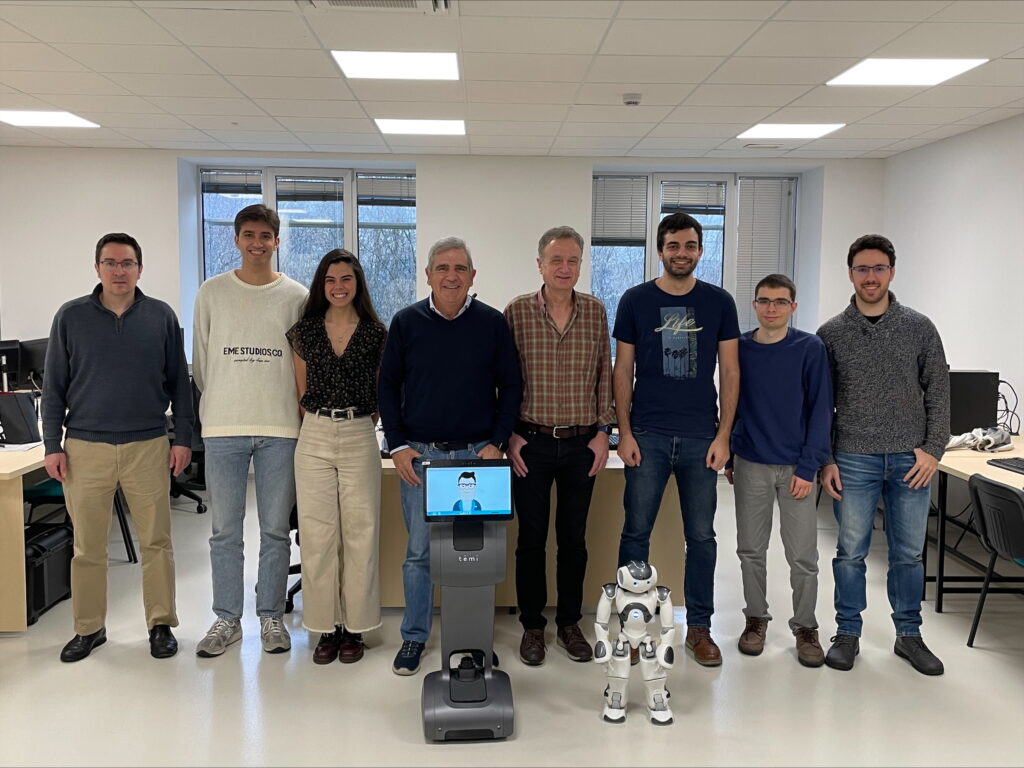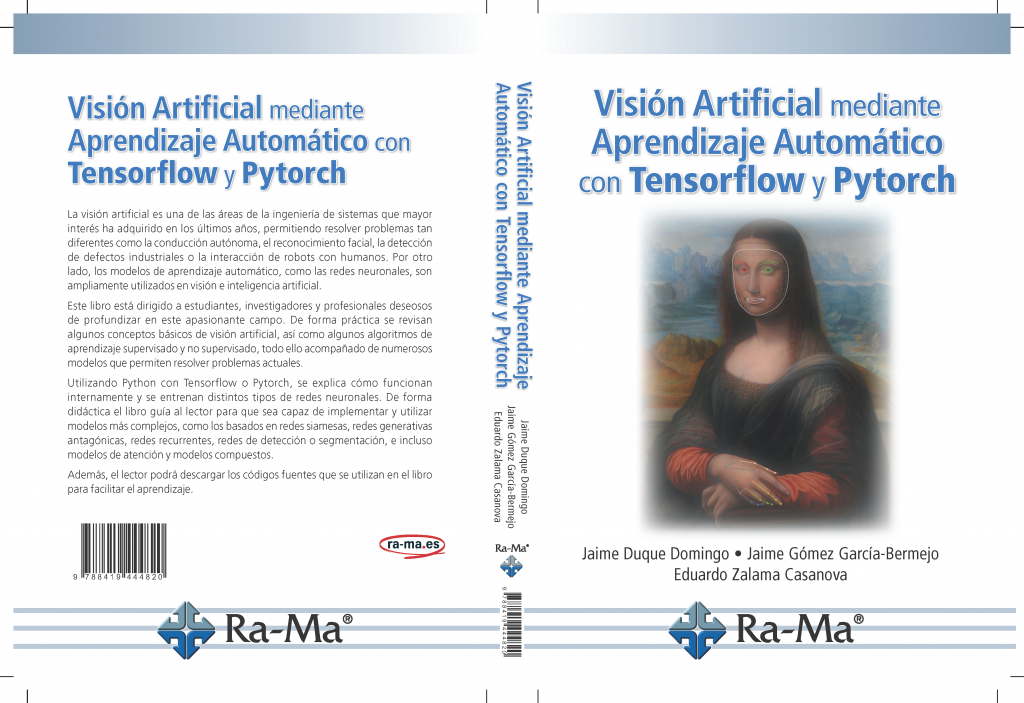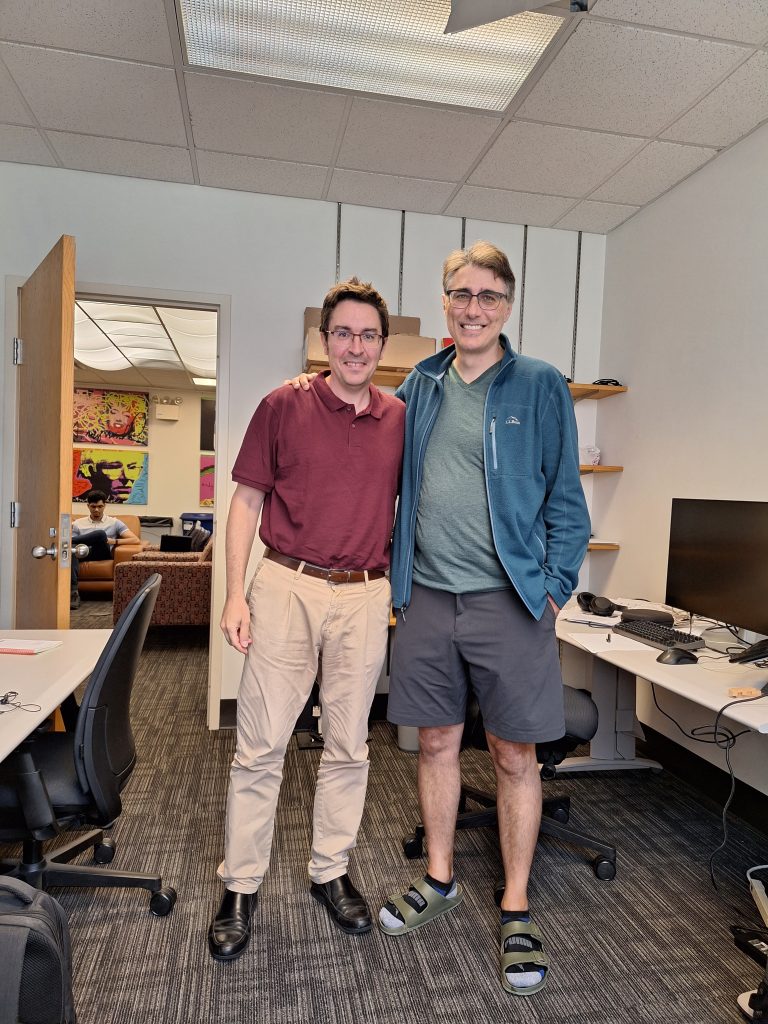
Professor in the Department of Systems Engineering and Automatics. University of Valladolid
e-Mail: jaime.duque@uva.es
LinkedIn: https://www.linkedin.com/in/jaime-duque-domingo-bb576565
Access my complete CV in Spanish:
https://cvn.fecyt.es/0000-0001-6649-5550
Main research fields
Computer vision, Social and collaborative robotics, Learning from Demonstration, Artificial intelligence, Deep learning and Human activity recognition.
Short Biography
I hold a Ph.D. in Systems and Control Engineering from the National University of Distance Education (UNED, 2018), awarded with Cum Laude distinction. I also possess a Master’s Degree in Research in Software Engineering and Computer Systems from UNED (2014) and a Master’s Degree in Secondary Education Teaching from Universidad Isabel I de Castilla (2018). In addition, I obtained a Bachelor’s Degree in Computer Engineering from the University of Valladolid (2011).
Throughout my research career, I have been the recipient of seven awards, notably the INFAIMON Award in 2015 and 2018 for the best paper on computer vision presented at the National Conference on Automation (Bilbao, 2015; Badajoz, 2018), the IARIA Award for Best Paper at the ICWMC Conference (Nice, France, 2017), and the Extraordinary Doctorate Award from UNED, conferred in November 2020.
Prior to my full dedication to academia, I accumulated eighteen years of professional experience in the private sector, where I developed complex information technology projects both in Spain and abroad. My work encompassed diverse domains, including insurance and banking (Seguros Caja Duero), governmental applications (French Social Security, through ATOS IT), the European Commission (Directorate-General for Informatics — DIGIT, Brussels), the automotive industry (Renault, Valladolid), and e-commerce (MachinePoint).
Following the completion of my doctoral studies in 2018, my professional focus shifted to academic and research activities. I have participated in numerous national and international conferences, contributed to scientific publications, and engaged in university teaching. I carried out a postdoctoral fellowship at the University of Valladolid, conducted research at the CARTIF Technology Centre, served as lecturer at Universidad Europea Miguel de Cervantes (UEMC), and currently hold a faculty and research position at the University of Valladolid. I have participated in five research projects at UNED, the University of Valladolid, and CARTIF, as well as in one project on educational innovation. My publication record includes two books on computer vision published by RAMA Editorial, twenty articles in first- and second-quartile journals indexed in the SCI-JCR, one book chapter on robotics and autism (RAMA), and thirty-four papers presented at national and international conferences, including major venues such as IROS 2024.
My principal research interests lie in the fields of computer vision and robotics, with an emphasis on deep learning methods, social and cognitive robotics, and positioning systems. As a researcher, I have been affiliated with the University of Valladolid and the CARTIF Technology Centre. Additionally, I have held visiting scholar positions at Carnegie Mellon University (CMU), Pittsburgh (United States), and at the PRISMA Laboratory, Department of Electrical Engineering and Information Technologies, University of Naples Federico II. I hold a nationally recognized six-year research period (sexenio).
In the teaching domain, I have lectured at the University of Valladolid and Universidad Europea Miguel de Cervantes, delivering courses such as Computer Fundamentals, Computer Vision, IT Consulting, Machine Learning Tools, Fundamentals of Control Systems, Applied Artificial Intelligence, Industrial Computing, and Information Systems. I have also supervised 15 bachelor’s or master’s theses, numerous student internships in companies, and one completed doctoral dissertation. I currently serve as a Permanent Faculty Member in the Department of Systems and Automatic Engineering at the University of Valladolid, accredited as Profesor Contratado Doctor by both ACSUCYL and ANECA. I have been awarded a five-year teaching service recognition.
Since September 2024, I have held the position of Coordinator of the Computer Vision Thematic Group of the Spanish Committee on Automation (CEA).
Our research group
Our research group carries out projects in humanoid and collaborative social robotics, computer vision, artificial intelligence, and home automation sensing. Our group is led by Full Professors Eduardo Zalama and Jaime Gómez García-Bermejo, renowned figures in the fields of robotics and computer vision. We are based in the Department of Systems Engineering and Automatic Control at the University of Valladolid. The University of Valladolid is one of the oldest universities in the world—the first in Spain if we consider the founding of its studies in Palencia in 1208.
I was co-supervisor of the completed PhD thesis of Raúl Gómez Ramos at the University of Valladolid. I am also co-supervisor of the PhD theses of Celia Sánchez-Girón, Miguel García Gómez, and Sergio Merino Fidalgo at the University of Valladolid, and of Raúl Fuentes Ferrer at the UNED.
Link to our research group: https://www.roboticavision.uva.es/


Books
- Visión Artificial: Componentes de los sistemas de visión y nuevas tendencias en Deep Learning. Ra-Ma. (2024). ISBN: 978-84-10181-67-0. URL: https://www.ra-ma.es/libro/vision-artificial-componentes-de-los-sistemas-de-vision-y-nuevas-tendencias-en-deep-learning_156248/

- Visión Artificial mediante Aprendizaje Automático con Tensorflow y Pytorch. Ra-Ma. (2023). ISBN: 978-84-19444-82-0. URL: https://www.ra-ma.es/libro/vision-artificial-mediante-aprendizaje-automatico-con-tensorflow-y-pytorch_146840/

Chapters in books:
- «Robótica, realidad virtual y tecnologías relacionadas para la detección, atención e intervención en TEA» en el libro «Autismo y Nuevas Tecnologías» de la editorial Ra-Ma. (2023). ISBN: 978-84-19857-99-6
Publications Q1-Q2 JCR Journals
- One-Shot Learning for Rapid Generation of Structured Robotic Manipulation Tasks from 3D Video Demonstrations. Journal of Intelligent Manufacturing. Springer (2025). Posición: 10/71 (IF: 7,4) DOI: https://doi.org/10.1007/s10845-025-02673-7
- Behavior tree generation and adaptation for a social robot control with LLMs. Robotics and Autonomous Systems. Elsevier (2025). Posición: 18/89 (IF: 5,2) DOI: https://doi.org/10.1016/j.robot.2025.105165
- Recognition of Egyptian Hieroglyphic Texts through Focused Generic Segmentation and Cross-Validation Voting. Applied Soft Computing Journal. Elsevier (2025). Posición: 24/175 (IF: 6,6) DOI: https://doi.org/10.1016/j.asoc.2025.112793
- Learning by Demonstration of a Robot Using One-Shot Learning and Cross-Validation Regression with Z-Score. Electronics. Multidisciplinary Digital Publishing Institute (2024). Posición: 172/366 (2,6) DOI: https://doi.org/10.3390/electronics13173365
- Development of a Human-Robot Interface for Cobot Trajectory Planning Using Mixed Reality. Electronics. 13 – 3, Multidisciplinary Digital Publishing Institute (2024). Posición: 172/366 (2,6) DOI: https://doi.org/10.3390/electronics13030571
- An Unsupervised Method to Recognise Human Activity at Home Using Non-Intrusive Sensors. Electronics. 12 – 4772, MDPI (2023). Posición: 131/275 (2,9) DOI: https://doi.org/10.3390/electronics12234772
- One Shot Learning with class partitioning and cross validation voting (CP-CVV). Pattern Recognition. 143, Elsevier (2023). Posición: 25/145 (8,0) DOI: https://doi.org/10.1016/j.patcog.2023.109797
- SDHAR-HOME: A Sensor Dataset for Human Activity Recognition at Home. Sensors(2022). Posición:14/64(3,576). DOI: https://doi.org/10.3390/s22218109
- Improving Human Activity Recognition Integrating LSTM with Different Data Sources: Features, Object Detection and Skeleton Tracking. IEEE Access (2022). Posición:94/273(3,671) DOI: https://doi.org/10.1109/ACCESS.2022.3186465
- Cross Validation Voting for Improving CNN Classification in Grocery Products. IEEE Access(2022). Posición:94/273(3,671) DOI: https://doi.org/10.1109/ACCESS.2022.3152224
- Improvement of One-Shot-Learning by Integrating a Convolutional Neural Network and an Image Descriptor into a Siamese Neural Network. Applied Sciences(2021). Posición:38/90(2,679). DOI: https://doi.org/10.3390/app11177839
- Daily Human Activity Recognition Using Non-Intrusive Sensors. Sensors(2021). Posición:14/64(3,576) DOI: https://doi.org/10.3390/s21165270
- Visual Recognition of Gymnastic Exercise Sequences. Application to Supervision and Robot Learning by Demonstration. Robotics and Autonomous Systems(2021). Posición:31/63(3,12). DOI: https://doi.org/10.1016/j.robot.2021.103830
- Optimization and Improvement of a Robotics Gaze Control System using LSTM networks. Multimedia Tools and Applications (2021). Posición:120/273(2,757) DOI: https://doi.org/10.1007/s11042-021-11112-7
- Egyptian Shabtis Identification by Means of Deep Neural Networks and Semantic Integration with Europeana. Applied Sciences(2020). Posición:38/90(2,679) DOI: https://doi.org/10.3390/app10186408
- Gaze control of a robotic head for realistic interaction with humans. Frontiers in Neurorobotics(2020). Posición: 69/139(3,272) DOI: https://doi.org/10.3389/fnbot.2020.00034
- Integration of Computer Vision and Wireless Networks to Provide Indoor Positioning. Sensors(2019). Posición:15/64(3,275) DOI: https://doi.org/10.3390/s19245495
- An improved indoor positioning system using RGB-D cameras and wireless networks for use in complex environments. Sensors(2017). Posición:16/61(2,475) DOI: https://doi.org/10.3390/s17102391
- Deciphering Egyptian hieroglyphs: Towards a new strategy for navigation in museums. Sensors(2017). Posición:16/61(2,475) DOI: https://doi.org/10.3390/s17030589
- Indoor Positioning System using Depth Maps and Wireless Network. Journal of Sensors(2016). Posición:126/262(1,704) DOI: https://doi.org/10.1155/2016/2107872
Some publications in International Conferences
- One-Shot Learning for Robotic Manipulators: Rapid Replication of Human Activities from a Single Demonstration. The workshop 11th Italian Workshop on Artificial Intelligence and Robotics in conjunction with the 23rd International Conference of the Italian Association for Artificial Intelligence (AI*IA 2024). Bolzano (Italy)
- Continuous Rapid Learning by Human Imitation using Audio Prompts and One-Shot Learning. IEEE/RSJ International Conference on Intelligent Robots and Systems (IROS 2024). Abu Dhabi (UAE)
- Ambient Intelligence Ecosystem for Elderly Pattern Detection and Care Using Social Robots. IEEE International Conference on Internet of Things (iThings 2024). Copenague, Danmark,
- Optimization of a Robotics Gaze Control System. International Workshop of Physical Agents (WAF 2020). Madrid (Spain)
- Locating Multiple Camera Sensors and Wireless Access Points for a Generalized Indoor Positioning System. ICWMC, 2017.Nice (France)
- A Vision-Based Strategy to Segment and Localize Ancient Symbols Written in Stone. Iberian Robotics conference. Sevilla (Spain)
- A semantic approach to enrich user experience in museums through indoor positioning. International Conference on Ubiquitous Computing and Ambient Intelligence, 2017. Philadelphia (USA)
- Indoor Positioning Prediction System based on Wireless Networks and Depth Sensing Camera. JNA 2016. Madrid (Spain).
- People Positioning System with Low Cost 3D Cameras and Wireless Devices for Indoor Environments. Robocity 2016. Madrid (Spain).
Visiting professor
- Visiting Professor for 3 months at Carnegie Mellon University (CMU), Pittsburgh (USA) (2023).

- Visiting Professor for 3 months at University of Naples Federico II, Italy (2024).



Some videos of our work